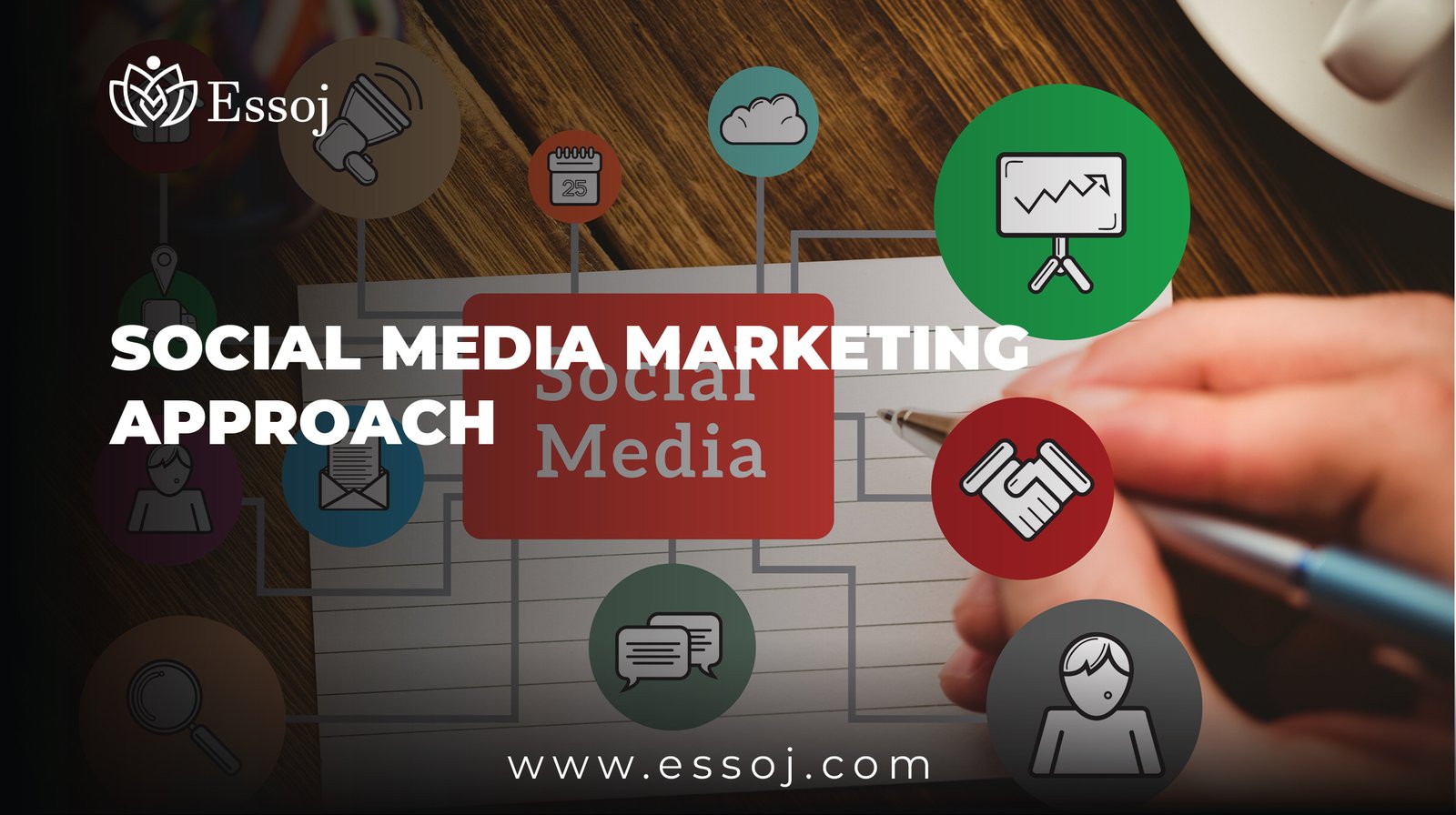In today’s digital-first world, having a strong social media marketing approach is more important than ever. Social media platforms are where millions of people spend hours daily, interacting with friends, brands, and content. This means businesses have a huge opportunity to reach potential customers, build relationships, and grow their brand through social media.
But not every business knows how to take full advantage of this space. Simply posting randomly or copying what others do rarely leads to success. Instead, what works best is a well-planned and executed social media marketing approach — one that guides every action from content creation to engagement and growth.
In this detailed guide, we will cover everything you need to know to develop an effective social media marketing approach that moves your brand from just showing up online to thriving with meaningful results.
What Is a Social Media Marketing Approach?
At its core, a social media marketing approach is a clear plan that defines how a business will use social media platforms to reach marketing goals. It’s a strategic method rather than a random or “post-and-pray” tactic.
This approach involves:
- Identifying your target audience
- Choosing the right platforms
- Creating relevant and engaging content
- Scheduling posts for consistent visibility
- Interacting with your followers
- Using paid ads strategically
- Measuring results and optimizing
Without this organized approach, brands risk wasting time, money, and effort on social media activities that don’t produce real value.
Why Your Business Needs a Social Media Marketing Approach
You might wonder why a formal approach matters so much. The truth is, social media has become crowded and competitive. Simply being present is no longer enough. Brands need to stand out and build a loyal following. Here’s why having a social media marketing approach is crucial:
- Targeted messaging: Ensures you talk directly to the people who matter most to your business
- Consistency: Keeps your brand visible and relevant with regular posting
- Better ROI: Maximizes returns from time and advertising spend
- Improved engagement: Builds meaningful relationships rather than superficial “likes”
- Data-driven: Uses insights to continuously improve your campaigns
For example, a small coffee shop that posts daily photos of new drinks and responds to every comment builds stronger community ties compared to one that posts sporadically and ignores followers.
Understanding Your Audience: The Heart of the Approach
A key step in any social media marketing approach is understanding who your customers really are.
Why is this so important?
Because your content, tone, and advertising should speak directly to the people you want to attract. The more you know about their interests, problems, and habits, the better you can tailor your messages.
How to Understand Your Audience:
- Analyze demographics: Age, gender, location, job, income
- Identify interests: What hobbies, brands, or topics do they follow?
- Study behavior: When are they active online? What content do they share?
- Use tools: Facebook Audience Insights, Google Analytics, or social listening platforms like Brandwatch
- Ask directly: Use surveys or polls to get feedback
For instance, a boutique selling handmade jewelry might find that most of its audience is women aged 25-40 who enjoy sustainable fashion. This insight helps craft the right content and ads.
Choosing the Right Platforms: Not All Social Media Are Equal
An important part of the social media marketing approach is picking the right platforms where your audience spends most of their time. Different platforms serve different purposes and user bases.
Popular Platforms and Best Uses:
- Facebook: Largest audience, good for community-building and ads targeting diverse groups
- Instagram: Highly visual, great for lifestyle, fashion, food, travel brands
- LinkedIn: B2B focus, ideal for professional services and networking
- TikTok: Short videos, popular among younger audiences, excellent for viral content
- Twitter: Real-time conversations and customer service
- Pinterest: Visual discovery, perfect for DIY, crafts, and home decor
For example, a fitness coach might focus on Instagram and TikTok to share workout videos and motivation, while a software company prioritizes LinkedIn and Twitter for thought leadership and client outreach.
Creating a Content Strategy That Works
Content is the backbone of any social media marketing approach. But content creation is not just about posting pictures or text randomly — it needs to serve a purpose.
What to Consider in Your Content Strategy:
- Content types: Photos, videos, stories, reels, live streams, blogs
- Themes: Educational, entertaining, inspirational, or promotional content
- Brand voice: Friendly, professional, humorous — whatever matches your brand
- Posting schedule: Frequency and timing to maximize engagement
- Content calendar: Plan content ahead to align with events, campaigns, and holidays
Example:
A bakery may post daily photos of fresh pastries (visual), share baking tips (educational), highlight customer testimonials (social proof), and run contests (engagement). This variety keeps followers interested and connected.
Engagement: The Two-Way Street of Social Media Marketing
Posting content is just one side of the coin. A winning social media marketing approach actively encourages conversation and community.
Ways to Boost Engagement:
- Respond to comments and direct messages quickly
- Use polls and quizzes to invite follower participation
- Share user-generated content (photos from your customers)
- Collaborate with influencers or local personalities
- Run contests or giveaways
One brand’s story illustrates this perfectly: A small clothing store doubled their Instagram engagement in three months just by personally replying to every comment and sharing customers’ photos wearing their clothes.
Incorporating Paid Advertising Into Your Approach
While organic content is valuable, paid advertising on social media platforms helps you reach a much wider and targeted audience.
Types of Social Media Ads:
- Boosted posts: Increase visibility of your best-performing posts
- Targeted ads: Use demographics, interests, and behaviors to reach specific groups
- Retargeting: Reach users who visited your website but didn’t convert
- Lookalike audiences: Find new potential customers similar to your existing ones
Budget and Testing:
Start with small budgets and test different ads to see what performs best. Use platform analytics to tweak targeting and creative elements continuously.
Measuring Success: Analytics and Adjustments
No social media marketing approach is complete without monitoring and optimization. Use analytics tools to track performance and make informed decisions.
Important Metrics Include:
- Reach and impressions: How many people saw your content?
- Engagement rate: Likes, comments, shares relative to followers
- Follower growth: New followers gained over time
- Website traffic: Clicks coming from social posts
- Conversions: Sales, sign-ups, or other desired actions
Adjust your strategy based on what the data shows. For example, if videos get more engagement than photos, focus more on video content.
Step-by-Step Guide to Build Your Social Media Marketing Approach
Let’s summarize the process to create your winning social media marketing approach:
Step 1: Set Clear Goals
Define what success looks like for your social media — awareness, sales, leads, etc.
Step 2: Research Your Audience
Use tools and surveys to understand who they are and what they want.
Step 3: Choose Platforms
Focus on 1-3 platforms where your audience is most active.
Step 4: Develop Content Strategy
Plan your content types, themes, and posting schedule.
Step 5: Engage Actively
Respond to followers and encourage participation.
Step 6: Use Paid Ads
Supplement organic reach with targeted advertising.
Step 7: Monitor and Optimize
Track key metrics and adjust tactics regularly.
Anecdote: How a Small Business Leveraged Their Social Media Marketing Approach
Take the story of a small local bookstore struggling with foot traffic. The owner, Maria, decided to revamp their social media marketing approach by focusing on Instagram and Facebook. She started posting daily photos of new arrivals, author events, and customer book recommendations.
Maria also engaged with followers by responding to every comment and hosting monthly giveaways. She invested a small budget in targeted Facebook ads to promote events.
Within six months, Maria saw a 40% increase in store visits and online orders. Customers told her they felt more connected to the bookstore through social media. This example shows how a consistent and thoughtful social media marketing approach can transform business outcomes.
Tips to Enhance Your Social Media Marketing Approach
- Stay updated with platform trends and algorithm changes
- Experiment with new content formats like reels or stories
- Leverage influencers to expand reach authentically
- Use tools like Hootsuite or Buffer to schedule and manage posts
- Analyze competitors to find gaps and opportunities
Final Thoughts
A strong social media marketing approach is essential for businesses aiming to build brand awareness, engage with customers, and drive growth in today’s competitive digital landscape. It’s not just about showing up but about showing up smartly with clear goals, deep audience understanding, quality content, active engagement, paid promotion, and ongoing analysis.
This approach transforms social media from a random activity into a powerful marketing engine that fuels your business growth and builds lasting connections. Remember, it’s a continuous journey that evolves as your business and audience change.
Start small, stay consistent, and let your social media marketing approach guide you toward long-term success.

